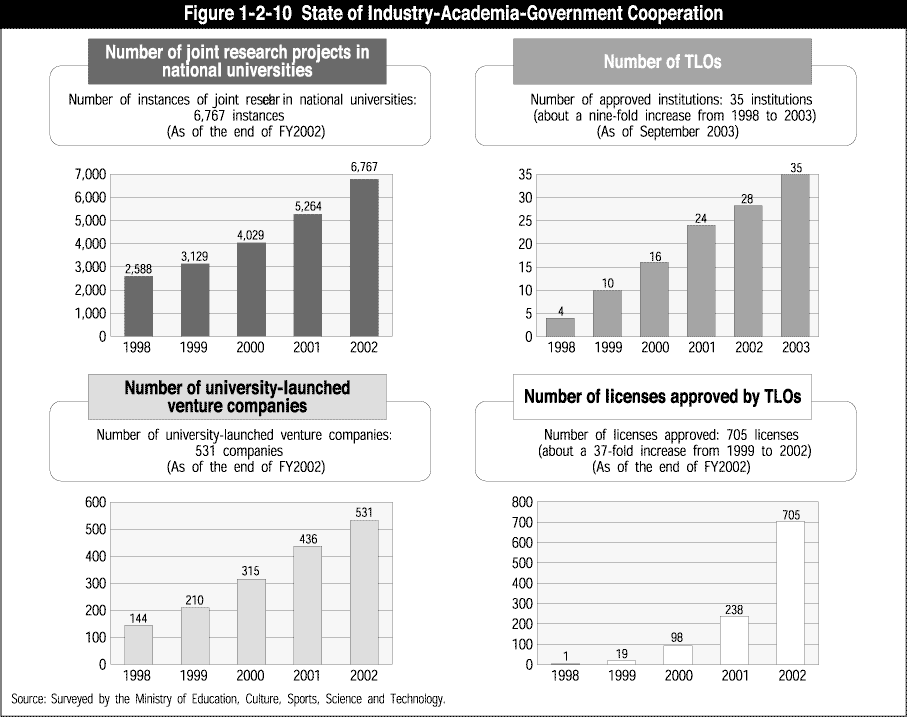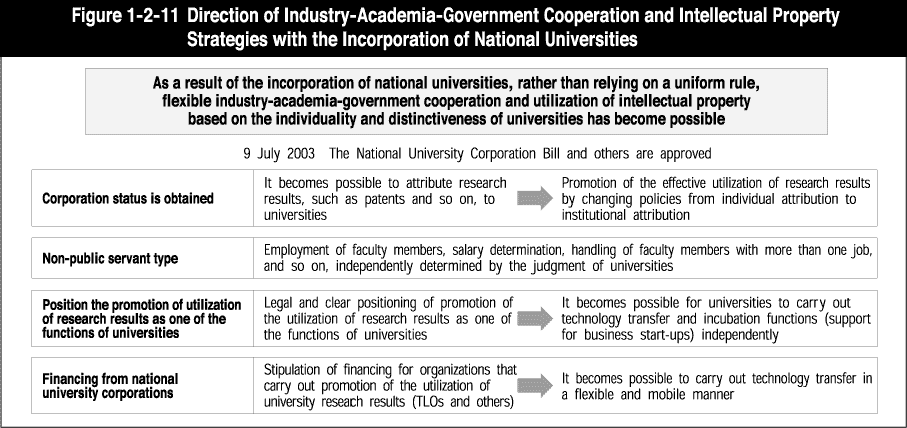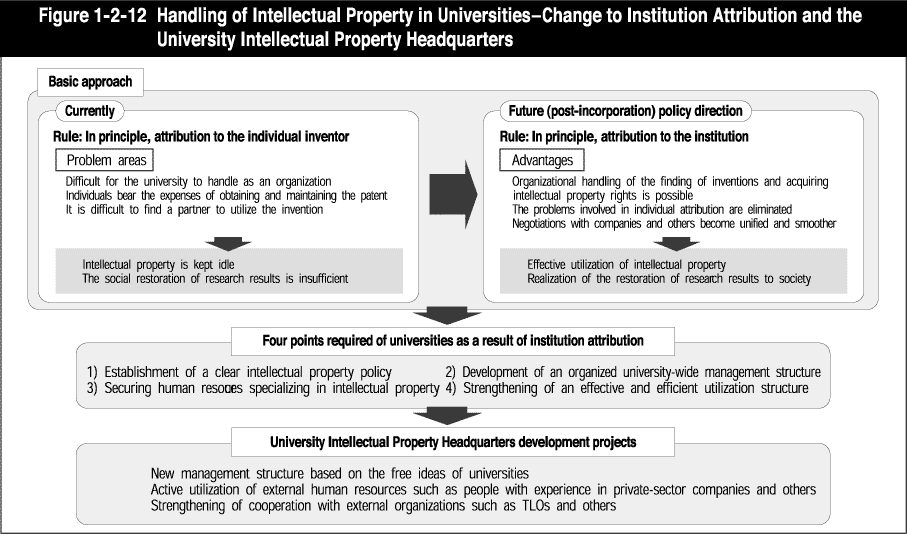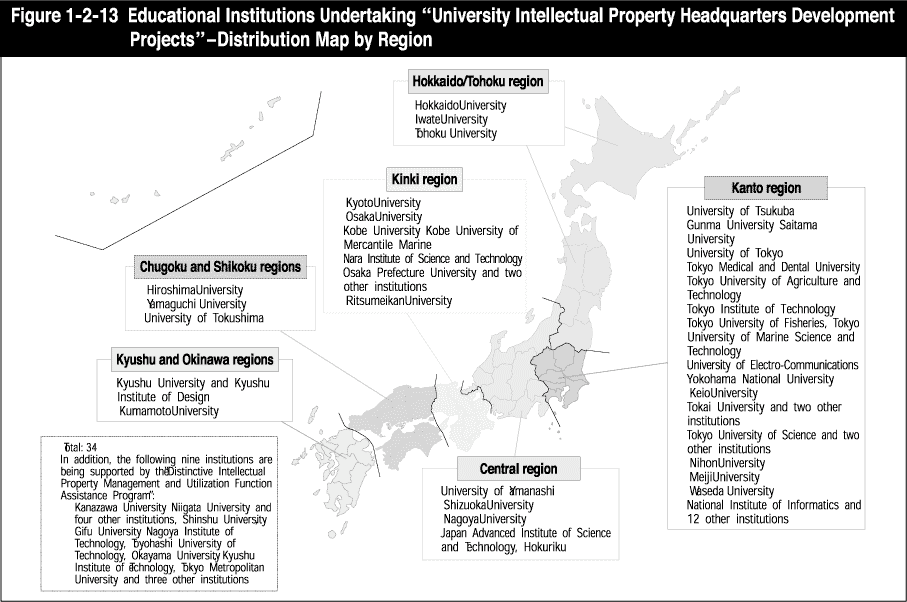| Home > Policy > White Paper, Notice, Announcement > White Paper > FY2003 White Paper on Education, Culture, Sports, Science and Technology >Part1 Chapter2 Section2.2 | ||
For Japan, aiming to become a nation based on creativity of science and technology, it is extremely important, through promoting organic industry-academia-government cooperation, to restore to society the benefits of intellectual creative activities by public experimental research institutions (experimental research institutions of the national and local governments, and independent administrative institutions and special institutions that carry out work concerned with experimental research) such as universities, and to communicate the needs of society to public experimental research institutions such as universities.
With these issues in mind, the importance of promoting industry-academia-government cooperation has been repeatedly indicated, for example in the 1996 Science and Technology Basic Plan and the 2001 second phase of the Science and Technology Basic Plan.
The government has actively made efforts to amend various systems in order to promote industry-academia-government cooperation, including enactment of the "Law Promoting Technology Transfer from Universities and Other Institutions to Industry." As a result, in recent years industry-academia-government cooperation in Japan has been strongly promoted and the number of university researchers and other educators with more than one job has significantly advanced. For example, the number of academia-industry joint research projects has more than doubled in five years, the number of patents licensed by specialized institutions (Technology Licensing Organizations (TLOs): 35 institutions as of2003) transferring the research results of universities and others to industry has reached about 700, and the number of university-launched ventures * exceeded 500 companies by the end of FY2002 ( Figure 1-2-10 ).
However, considering that the research and development ability of universities in Japan is of the highest level even by global standards, it can be concluded that the acquisition of intellectual property rights for, and the utilization of, the research results of universities and others is not necessary sufficient, and it is necessary to deepen them further. In addition, there are increasing demands from regions and industry to proceed cooperatively with universities to cultivate human resources, create new industries and others. MEXT, in cooperation with related ministries and agencies such as the Ministry of Economy, Trade and Industry, is more actively carrying out various kinds of support to promote the creation of university-launched ventures and industry-academia joint research, and others( Figure 1-2-11 ).


| * Venture |
A venture is a new company established on the basis of original research and development by universities and others.
With the incorporation of national universities in FY2004, as each university will be given independent corporate status, their managerial discretion will be expanded. At the same time, the faculty members will not have the status of public servants, so the regulations of the National Public Service Law and others will no longer be applied to them. To promote industry-academia-government cooperation, it is important for the people involved to make autonomous, independent efforts, but, taking advantage of the opportunity provided by the incorporation of national universities, a wide range of regulations concerning the budget, organization, personnel system and others were greatly relaxed, making it possible for national universities to take responsibility themselves for developing industry-academia-government cooperation. As a result, it is expected that they will develop industry-academia-government cooperation further.
On the other hand, as the globalization of economic activity and changes to the industrial structure proceed, there is a strong awareness of the necessity to proceed strategically with the acquisition, utilization, and so on, of intellectual property. Therefore, in July 2002, the "Intellectual Property Policy Outline" was decided by the government's Strategic Council for Intellectual Property, and in line with these guidelines, the "Basic Law on Intellectual Property" was enacted in December 2002. In addition, in July 2003, based on this Basic Law, the "Strategic Program for the Creation, Protection and Exploitation of Intellectual Property," which states the specific plan for implementation, was drawn up by the Intellectual Property Strategy Headquarters (Chairman: the Prime Minister), and specific efforts in line with this program are required.
Universities play a big role in supporting "knowledge creation," which is the starting point in the creation-management-utilization cycle of "knowledge," and it is an urgent matter for them to develop a structure to proceed with the strategic acquisition and utilization of intellectual property.
Along with incorporation beginning from FY2004, there will be a change to a policy of attributing university research results, such as patents and others, in principle, to institutions rather than the government or individuals as is done currently. For this reason, it is important for national, public and private universities to develop a structure to enable strategic management of the creation, acquisition, management and utilization of intellectual property. MEXT has since FY2002 selected 34 Model Development Institutions and 9 "Distinctive Intellectual Property Management and Utilization Function Assistance Program" support institutions as development projects for University Intellectual Property Headquarters. In the future, it is important for industry-academia-government cooperation and intellectual property strategy to be positioned in the management policies of universities and for them to be implemented in cooperation with related institutions, and through the promotion of this project, it is expected that they will proceed smoothly.
MEXT, through the following policies, considers that the "knowledge" created by universities and others gives new vitality to social and economic activities, and the fact that research and development at universities and others develops substantially in response to the new needs and ideas of society makes a big contribution to the formation of an intellectually based society rich in creative vitality( Figures 1-2-12 and 1-2-13 ).


| Back To Top | MEXT HOME |